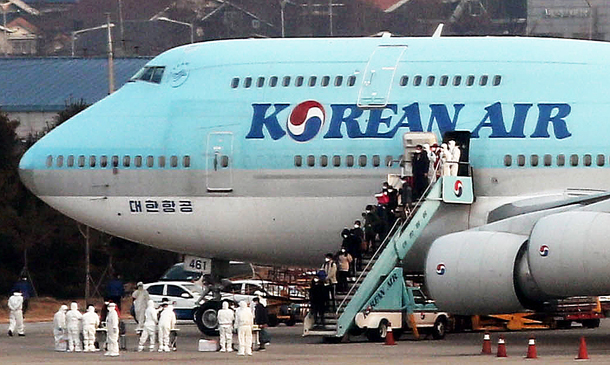Korea sees its first tertiary infections of coronavirus

South Korean nationals evacuated from China's Wuhan disembark from a chartered flight at Gimpo International Airport on Friday. [YONHAP]
Korea confirmed five new coronavirus cases on Friday, bringing its total number of diagnosed cases to 11.
Two of the new patients are believed to have contracted the disease from Patient No. 6, who was infected by patient No. 3, a Korean man who was living in Wuhan, China, the epicenter of the outbreak of the disease.
That makes them tertiary infections, the first in Korea for this outbreak.
According to the Korea Centers for Disease Control and Prevention (KCDC), two of the five patients confirmed Thursday and Friday have been dubbed Patients 7 and 8. The other three have not been labeled.
Patients 7 and 8 appear to have contracted the disease in Wuhan and the other three locally.
Patient No. 7 is a 28-year-old Korean man studying in Wuhan who took a flight from Qingdao, Shandong Province, to Incheon International Airport on Jan. 23. On that same flight was a 62-year-old woman who has been identified as Patient No. 8.
Health officials said Patient No. 7 began showing symptoms on Sunday before building up a fever of up to 37.7 degrees Celsius (99.9 degrees Fahrenheit) on Wednesday. Local health authorities said they classified the patient as a likely carrier of the virus and transferred him to a government-designated hospital on Wednesday.
On Thursday, his test results were positive, and the patient is currently being treated at the Seoul Medical Center in northern Seoul, according to the KCDC.
Patient No. 8, who also visited Wuhan and returned by way of Qingdao, has been isolated in a state-designated hospital in Iksan, North Jeolla.
The other three cases confirmed Friday were all contracted in Korea.
One was traced to Patient No. 5, a 32-year-old businessman who returned Jan. 24 from a business trip to Wuhan. Health officials screened the 10 people he came into contact with after his return, and one tested positive Friday, the second secondary transmission in Korea.
The remaining two local transmissions are more of a mystery because authorities have kept details to a minimum. But it is almost certain they are tertiary infections that go back to Patient No. 3, a 54-year-old Korean man who recently returned from Wuhan. He was the most heavily scrutinized by the government — and criticized by the public — for roaming around Seoul and nearby Ilsan, Gyeonggi, from Jan. 20 to 26.
After surveying the patient’s credit card and phone records, health officials now believe he had contact with a total of 95 people, up from the 74 originally estimated by the KCDC and the largest number of any of the diagnosed patients.
On Jan. 22, Patient No. 3 shared a meal at a posh Korean restaurant in the district of Gangnam, southern Seoul, with a 56-year-old Korean man who became infected with the disease — and was labeled Patient No. 6 on Thursday.
According to health officials, Patient No. 6 spent the Lunar New Year with his daughter and her husband at his residence in Seoul.
The couple returned to their home in Taean County, South Chungcheong, where from Tuesday to Thursday the husband went to work at the Korea Power Learning Institute and the wife at a day care center where she teaches.
All eight people who came into contact with patient No. 6 since Jan. 22 have been quarantined inside their homes and tested for the virus. Authorities have not confirmed whether the two new patients are Patient No. 6’s daughter and son-in-law, but the KCDC did reveal that they are his relatives.
Patient No. 6’s daughter was in close contact with 29 toddlers aged between 2 and 3 years old at her day care center. Given that the young lack fully developed immune systems, they are at greater risk of contracting the virus.
Taean’s local government shut down the day care center where the daughter of patient No. 6 worked.
The growing number of human-to-human transmissions of the virus outside of China prompted the World Health Organization (WHO) Thursday to declare the coronavirus outbreak a “public health emergency of international concern,” or PHEIC.
The designation gives the organization capabilities to push governments around the world to contain the disease and coordinate its containment. WHO’s Director-General Tedros Adhanom Ghebreyesus said there were now 98 confirmed cases in 18 countries outside of China as of Thursday, and that the declaration was aimed at helping countries with weak public health systems prevent the spread of the virus.
In China, where infections first emerged in Wuhan in December, officials confirmed the virus had infected 9,820 people so far, killing 213.
While people infected with the new coronavirus may not show signs of illness for days, common symptoms include a fever, coughing, muscle pain, chills and difficulty breathing.
The KCDC advises all people with such symptoms to wear a face mask at all times, and anyone who shows such symptoms after visiting China’s Hubei Province, where Wuhan is located, within 14 days to call the KCDC’s hotline at 1339.
All foreigners who require translation to communicate their situation regarding the virus can call the Korea Tourism Organization’s travel hotline at 1330 or the Immigration Contact Center at 1345.
BY SHIM KYU-SEOK [shim.kyuseok@joongang.co.kr]










with the Korea JoongAng Daily
To write comments, please log in to one of the accounts.
Standards Board Policy (0/250자)